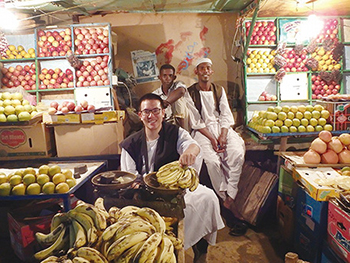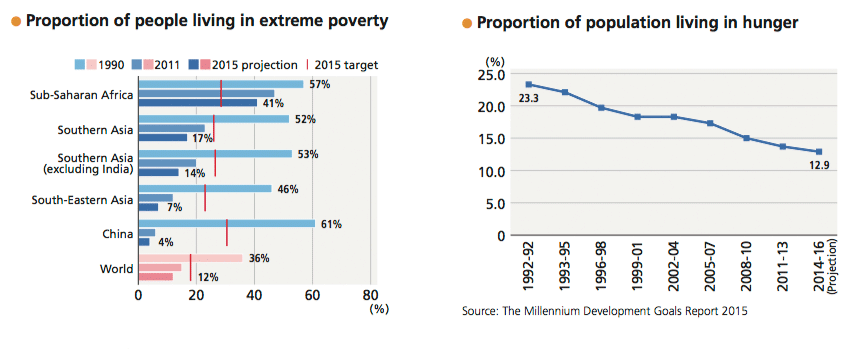Section 3 MDG Progress Status
Thanks to these efforts by Japan and the concerted efforts of the international community, some advancements were made in achieving the MDGs by the 2015 deadline.
That is not to say, however, that all of the goals have been achieved. There were goals that were not achieved by 2015 as well as uneven progress between the regions. In this regard, there are challenges still remaining. These circumstances are summarized in The Millennium Development Goals Report published by the UN (the figures below are all taken from the 2015 report).
1. Results achieved

A Japan Overseas Cooperation Volunteer, Mr. Tomoya Suzuki conducts an agricultural product survey in the state of Kassala, Sudan. (Photo: Tomoya Suzuki)
An example is the achievement made in the first MDG to eradicate extreme poverty. It identified a specific target: halve the proportion of people who suffer from extreme poverty by 2015 (compared to 1990) (Target 1.A). In 1990, approximately 36% of the world population (approximately 1.9 billion people) suffered from extreme poverty. The efforts made, however, resulted in that proportion dropping to one-third of the initial figure to approximately 12% (approximately 840 million people) in 2015. The target was thus achieved. It is considered that the rapid economic development in China and India, which accounted for a significant proportion of the population in extreme poverty, had a major impact on this achievement. It must not be forgotten that despite this achievement, 41% of the population in Sub-Saharan Africa still lives in extreme poverty.
The target to halve the proportion of people who suffer from hunger compared to the 1990 level (Target 1.C) has also been achieved for the most part. The proportion of undernourished people in the developing regions has fallen from 23.3% in 1990-1992 to 12.9% (estimate) in 2014-2016. Nevertheless, there is considerable unevenness across regions. Progress to reduce hunger has been slow in Sub-Saharan Africa, South Asia, and West Asia.
In addition, remarkable improvements were observed in the indicators related to combating infectious diseases. For example, new HIV infections in the world fell by approximately 35% between 2000 and 2014. Thanks to the advances in anti-infectious disease measures, it is estimated that over 6.2 million lives in the world were saved from malaria between 2000 and 2015 and approximately 37 million lives were saved from tuberculosis between 2000 and 2013.

